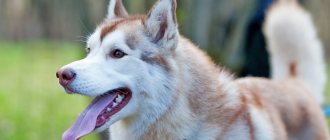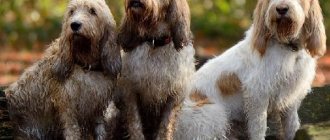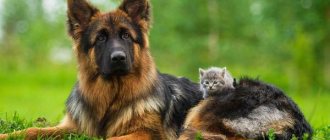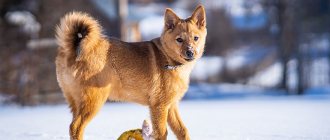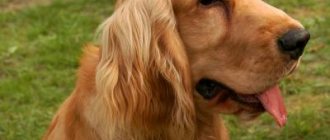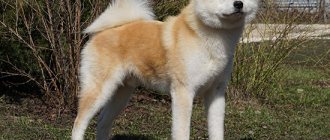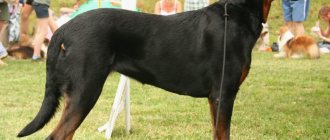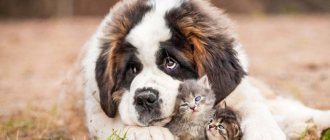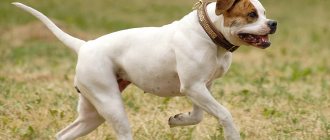Brief characteristics of the Coton de Tulear dog breed
- Other possible dog names: Madagascar Bichon, Coton de Tuléar, Coton, "Cotie".
- Height of an adult dog: 28-33 cm for males and 22-28 cm for females.
- Weight: 4-6 kg.
- Characteristic color: usually snow-white, sometimes there are fawn spots on the head, which are not considered a defect.
- Coat length: long, about 8 cm, can be wavy.
- Life expectancy: 14-15 years.
- Advantages of the breed: compact size of the dog, health, friendly and affectionate character, intelligence.
- Difficulties of the breed: requires very careful grooming, loud barking.
- Average price: from 1200 to 1300 euros. It is almost impossible to buy a purebred dog in Russia; this breed is still not widespread here.
Description of the breed
The Coton de Tulear is a breed with excellent decorative qualities and a strong character. The advantages of these dogs are not limited to their charming faces. Once upon a time they saved their owners' supplies from rodents, but now brave dogs happily participate in energetic games and get along well with kids.
Appearance
The Madagascar Bichon has dark, wide-set eyes. The gaze is open, ready to communicate with humans and other animals. The physique is strong with a broad chest and muscular back, the tail is of medium length, raised to the top. A characteristic feature is long snow-white hair (up to 6–8 cm), soft and pleasant to the touch. More often it is straight, but it can also be slightly wavy; there are small fawn spots in the ear area. It is generally accepted that the optimal ratio of the height of a Coton de Tulear to its length is 2 to 3. Males at the withers are 28 cm, and females are 25 cm.
Despite their small size, the dogs look harmoniously developed with correct proportions.
Character and temperament
If when talking about the appearance of the Coton de Tulear, the first thing that comes to mind is its “cotton” coat, then when mentioning the temperament of these dogs, it is first of all worth noting their family nature. They become strongly attached to all household members and get along well with other animals. The Madagascar Bichon is a smart and active dog. His joyful, booming voice seems to invite all family members to take part in a fun game. The dog will be happy to join in any activity, including traveling in the car and going out of town.
Read Description of the peculiarities of owning a Caucasian Shepherd dog
The Coton de Tulear's natural intelligence is high, it learns commands and adapts to its environment. If the owner is busy with his own business, the dog will calmly wait for him, looking around. Due to their small stature, dogs like to settle on high ground and watch what is happening from there. Favorite places in the house are cabinets and coffee tables.
Their good-natured, playful nature makes Madagascar Bichons excellent companions, but poor guard dogs. Because of their love of life and ability to cheer up others, the French call representatives of the breed “clowns.”
Health and life expectancy
The lifespan of the Coton de Tulear is 14–15 years. These are strong dogs that rarely have health problems. There are isolated cases of illnesses that are not widespread. The most common injury is a luxated kneecap. Since childhood, Cotons have been energetic and fearless. Puppies tend to jump off high furniture, so it is important to protect them from themselves. Until the joints are fully formed, babies need to be closely monitored.
One of the hereditary diseases is hip dysplasia, which causes pain for the dog when walking. Lameness is not always noticeable and symptoms may be almost invisible. Rapid growth from high-calorie diets and injury will aggravate the development of the disease. As your dog ages, he may develop arthritis.
Another hereditary disease is progressive retinal atrophy, which threatens complete blindness. Breeders annually check the health of their pets and do not allow dogs with these diseases to breed. Some problems are difficult to diagnose before 2 years of age, so reputable kennels select only absolutely healthy dogs over this age for breeding. A good breeder will provide documents confirming the absence of pathologies in the animal. A health certificate from the parents guarantees that the puppy has no hereditary problems.
History of the origin of Coton de Tulear
The breed originated naturally in Madagascar. The descendants of modern Coton de Tulear are considered to be Maltese dogs, which were brought to the island by pirates in the 16th-17th centuries. The union of these lapdogs and the local island dogs resulted in the Madagascar Bichon . Small and friendly creatures quickly attracted the attention of the royal family of Madagascar and for many years only they had the privilege of keeping a Coton as a companion dog.
This breed became known to the general public only in the 60s of the last century, when they finally came to the homeland of their ancient ancestors (lapdogs) along with the returning French colonists. It's funny that at that time the breed was just on the verge of extinction, and only great interest on the part of Europeans helped it survive a difficult period and be born again. In 1972, it was officially recognized by the Fédération Cynologique Internationale, and at the same time received strict standards and its beautiful modern name.
The Coton de Tulear is still a fairly rare breed , and litters usually produce no more than 3 puppies. Most often found in France. The American Kennel Club only recognized the Coton as a breed in 2014. They are very similar to their “brothers” Bichon Frize.
What can your pet get sick with?
Despite its fragile appearance, the Coton de Tulear has good health. Average life expectancy is 14–16 years. This breed has no genetic diseases, but like most small dogs, the Coton de Tulear can suffer from:
- Progressive retinal atrophy is a vision disorder caused by the loss of photoreceptors in the inner wall of the eye. Leads to complete blindness. To date, there are no medications or treatments for the disease.
- Dislocation of the knee joint (dysplasia) is a disease in which the patella, consisting of three parts (thigh, patella and tibia), is in an incorrect position. The disease does not manifest itself from birth, but throughout life in the form of lameness or abnormal gait. An improperly formed joint or one damaged as a result of injury with constant contact “erases” the cartilage tissue, causing pain. The destruction process then affects the bone. This pathology prevents the pet from leading an active lifestyle. If the disease is detected in the early stages of its development, it is possible to stop the destruction process, otherwise the dog will remain disabled.
Dysplasia can cause pet disability
Purpose and character of Coton de Tulear
as companions for many centuries . These small dogs are very friendly and affectionate to the owner as well as his family. They get along well with children. Moreover, they do not require such careful treatment as other breeds of small dogs.
The Coton guard dog is, to put it mildly, bad. This friendly little guy would rather show a stranger into the house, considering him a potential friend, than drive him away. Nevertheless, the Coton always regularly notifies about the appearance of unexpected guests.
In France, Cotons are often called “clowns” . Not without reason. These small dogs love to amuse their owners so much that they tend to behave playfully and humorously almost all the time. Many cats love to please their owners with tricks and nonsense. Their character is often compared to Labrador retrievers.
Cotons are very attached to their family . They strive to always be in the company of close people and experience long separation very painfully - they begin to bark loudly and spoil all the things that come their way.
This breed is much better suited for families with children than other similar ones. Cotons get along well with children, and some even prefer their company, trailing them all day long.
The friendliness of fur babies extends not only to the owner's family members, but also to strangers. Often the dog has to be weaned from greeting all guests by jumping on the face and licking. However, there are also some Cotons that form very strong bonds with their owners and are conservative towards strangers.
The Coton gets along quite easily with other dogs and pets. He is not characterized by aggression .
Features of the appearance and character of the breed
According to the current standard, the Coton de Tulear is classified as a companion dog. A distinctive feature of this breed is its long coat with a cotton structure. Externally, dogs of this breed resemble lap dogs.
External characteristics of the breed
In cynology, there are special standards according to which dogs are divided into breeds. Thus, a purebred Coton de Tulear must meet the following parameters:
- the ratio of the dog’s height to body length is 2:3;
- ratio of head length to body length - 2:5;
- ratio of skull length to body length - 9:5;
- round head, triangular when viewed from above;
- the skull is wide, slightly rounded;
- well developed cheekbones;
- light cranial groove;
- black nose (brown color is allowed);
- the nostrils are wide;
- lips are thin, matching the color of the nose;
- scissor and straight bites, an inverted scissors bite is possible;
- teeth are straight;
- the eyes are round, dark, widely spaced;
- the color of the eyelids matches the color of the nose;
- the ears are triangular, long, adjacent to the cheeks and ending at the tips of the lips;
- the skin is tight, does not sag, pink (may be pigmented);
- ratio of neck length to body length - 1:5;
- the upper line of the back is slightly elongated;
- the chest is lowered to the level of the elbows;
- the tail is set at the same level with the spine, curved upward (in dogs with very long hair, the tip may touch the back);
- limbs are located vertically;
- the length of the shoulder is equal to the length of the shoulder blade;
- glenohumeral joint angle - 120°;
- the length of the shoulder is equal to the length of the forearm;
- paws are small, round;
- fingers fit tightly to each other;
- finger pads are colored;
- hip angle - 80°;
- the angle between the shin and thigh is 120°;
- hock angle - 160°;
- coat: thick;
- soft, elastic, cotton-like;
- white, light gray or fawn color on the ears is allowed.
- females - 23–25 cm;
- females - 3.5–5 kg;
The Coton de Tulear breed standard allows for light gray and fawn coloration in the ear area
Personality of the Madagascar pet
The Coton de Tulear has a number of positive characteristics, which may prompt the breeder to choose this breed. The dog is very cheerful, friendly and active. She is smart and quick-witted. A companion pet gets along equally well both in a city apartment and in a country house (but not on the street). In addition, it is ideal for families with children. Mutual understanding is immediately established between the child and the dog. The pet prefers active games in the fresh air.
There is one very interesting feature of this breed - when playing, the Coton de Tulear jumps, lifting all four limbs off the ground. It looks cute and funny, so it brings a smile to passers-by and to the breeders themselves.
One of the disadvantages of the breed is that the dog does not tolerate loneliness, which means that it cannot be left alone at home for a long time. Fortunately, the pet is miniature, which allows you to take it with you.
The Coton de Tulear is an excellent guard dog that is wary of strangers and can respond to them with a loud bark. Another feature of the breed is patience. The dog will not bother its owner if he is busy, but will wait until he is free.
For rest, the pet chooses places with the best view in order to monitor the events taking place in the house. This could be a table, chair, high stand, etc.
I am the happy owner of a Bichon Frize puppy - the closest relative of the Coton de Tulear. I bought my pet when he was only 2.5 months old. It cost me 500 USD. This breed is quite common in Russia and Belarus, so it was not difficult for me to find a breeder. I have never once regretted purchasing such a four-legged friend. The dog is really very affectionate, patient and cheerful. But she just can't stand being alone. At the first stages of our acquaintance, I did not know this, so I was regularly surprised at home in the form of disheveled slippers, torn wallpaper and scattered things. I chalked it all up to the fact that the puppy was still small, but every day he became more and more mischievous. Now every day I take the puppy with me to work, where he already has his favorite place, toys and bowls with food and water.
Video: short video review of the Coton de Tulear breed
How to choose a Coton de Tulear puppy
Proper socialization is necessary for any pet, including cats. Therefore, you should not take a puppy under 2 months old who has not yet learned to behave among his own kind.
When you take an adult cat , you need to keep in mind that its character has already been formed. This way, you will get the dog as he already is, and not as you want. It is worth considering that some cats become very attached to their owners and will take a very long time to get used to new owners. At the same time, they will miss their old owners, bark loudly and often, and damage furniture and other things in the house.
When choosing a puppy from a litter, pay attention to their behavior. Do not choose particularly lively ones, as raising them will require more patience and effort. Also, do not give in to pity and give preference to the weak and timid. The ideal option is a puppy that is quite confident, but not too impudent. Raising such a pet will be the easiest.
Different organizations have their own breed standards , but in general, the Coton de Tulear should have a very soft coat (comparable to a cotton ball), a prominent black nose, large, wide-set round black eyes, and somewhat short legs.
The main color of the coat should be white (at exhibitions, preference is given to completely white coats). On the ears, light gray and red-brown colors are acceptable. In other areas there may be spots of various colors, but provided that they are not very pronounced against the background of the main white.
Price and selection of puppies
Those wishing to get a Coton de Tulear puppy should remember that the breed is not very common in Russia. Dogs may not be available for free sale. Those who are aiming to adopt a pet of this particular breed are recommended to reserve their babies even before mating. There is a possibility that puppies will be quickly snapped up due to the small number of reputable breeders.
Read Is the Keeshond, aka Wolfspitz, dog breed right for you?
Another option is to buy a Coton from a responsible fancier who breeds his own dog. It is necessary to make sure that the seller has selected a pair through the club and registered the litter. Before purchasing, you should personally inspect the living conditions of the dogs. The puppy must have a brand, a puppy card and vaccination records.
It is advisable to take your baby to a new home no earlier than 2.5 months. In babies, dark marks on the face and body are acceptable; this is not a sign of mixing with another breed. By the age of two, the spots will disappear and the dog will become completely white. Puppies are ready to go to a new home at the age of 2.5 months. On average in Russia, the price for a Madagascar Bichon from a receiver is 50,000 rubles; fanciers ask for less - from 30,000 thousand. The cost is influenced by the pedigree of the parents, the status of the breeder, and the prospects of the puppies. Girls are slightly more expensive than boys. In the West, prices are much higher. In America, the lower limit is $2,000, show-class dogs cost from $3,000.
Maintenance and care of Coton de Tulear
Cotons are ideal dogs for home keeping. Firstly, they don't take up much space. Secondly, do not scatter wool everywhere. They shed slightly, but all the hairs remain in the coat. Unlike most dogs, Cotons have almost no smell.
Cotons feel great outside. They love snow. However, it is better to keep them indoors, as outside without company they will bark intensely and loudly out of loneliness.
Cotons are one of the most energetic miniature dogs. They can run after their owner for hours. Therefore, unlike other small dogs, they need more time for active entertainment - at least 30-45 minutes a day. Otherwise, hyperactivity, destructiveness and excessive barking develop. However, if it is not possible to play with your pet during the week, one active day on the weekend will also be enough.
One of the few difficulties is grooming . What do we have to do:
- Regularly comb the fur, remove tangles, and remove debris;
- wash the coat (as it gets dirty);
- When washing, use special products for dogs;
- remember: haircuts and curling are not required for Cotons;
- Before exhibitions, do special grooming.
Cotons easily grow claws, which can be damaged, so you need to trim them on time. At least once a month, dogs need to have their ears examined and carefully cleaned.
Content Features
The Coton de Tulear is great for apartment living due to its calm, intrusive nature, small size and lack of shedding. Moreover, these dogs, as befits other decorative breeds, should live with their family. They thrive in human society and languish when left unattended. The option of keeping it outside, in an enclosure, or even in an outbuilding should not even be considered. In everyday life, the Coton is usually problem-free; it is easy to relax and travel with it.
Hypoallergenic Coton de Tulear
Coton de Tulear are classified as one of the hypoallergenic (non-shedding) breeds. However, in matters of sensitivity, everything is individual. Before getting a Coton, you need to closely communicate with a representative of the breed and make sure there is no allergic reaction.
Care
A Coton de Tulear puppy requires virtually no care, but owners should not entertain the illusion that everything will remain the same in the future. In addition, it is important to teach your baby from an early age to care for fur and all the tools that he will need in the future.
It is very difficult to keep the Coton de Tulear looking neat and clean for show. The coat does not shed, so it requires regular combing and trimming. Around the eyes, nose, and between the fingers, the white hair turns reddish-brown. This is the norm for the breed, but it spoils the appearance. Therefore, dogs that are exhibited have their fur constantly and regularly bleached with special products. For “sofa” pets this is done at will. At exhibitions, cotton is shown in its most natural form. A small haircut is allowed to give the coat a more neat appearance.
Coton de Tulears get a wide variety of haircuts for beauty and ease of care.
It is advisable to comb the Coton's fur daily. Bathed once every 2-3 weeks. It is very important to check your dog for mats before bathing. If there are any, they are unraveled. After bathing, they will tighten so much that you will have to cut them off. For washing, use shampoos for soft white wool and conditioner to make combing easier. It is important to dry the wool well or allow it to dry naturally, avoiding hypothermia and drafts during this time. After bathing, the ears are examined and cleaned.
Eyes are wiped daily or twice a day. After eating, it is customary to rinse the face. The wool is self-cleaning, it remains white even after walks, but not in rainy weather. Nails are trimmed as needed, usually once every 3-4 weeks.
Nutrition
The Coton de Tulear needs a nutritious, balanced diet to keep it healthy and active. The owner determines the type of feeding based on the dog’s personal convenience and preferences. This can be one of four options: dry or wet food above the premium class, home-cooked food or feeding raw foods according to the BARF system. Cotons are usually not prone to overeating, but they will begin to overeat foods if they are spoiled. For normal digestion, it is also important to follow portions and regimen. Clean drinking water must always be freely available.
What to feed your Coton de Tulear
The puppies' diet should be rich in protein, calcium and calories. You need to feed 3-4 times a day. Place a bowl of food only for 30 minutes to get used to the routine.
Puppies can be switched to solid food from 8 weeks after birth.
Starting from 9 months, Cotons are fed 2 times a day. You should also switch to adult food, since puppy food is too high in calories.
There is no consensus which option is preferable for the breed. If the owner chooses dry food, then it should be premium food; if natural, then it is necessary to plan the diet so that the dog’s fur receives a sufficient amount of nutrients. The menu must include vegetables and fruits, meat and fish, and the required amount of vitamins.
Do not eat: legumes, potatoes, raw pork (and other fatty meats), wheat, barley and pearl barley.
Care and maintenance
The main points in caring for Cotons are the correct selection of food and due attention to the long, thick coat.
Nutrition
The Madagascar Bichon requires a special diet. This is either a special food that takes into account all the needs of the breed, or a balanced diet from natural products. If the owner prefers the second option, he will have to carefully plan the menu. The pet needs food rich in carbohydrates, meat, fish. The list of prohibited foods includes raw pork, fatty lard, pearl barley, wheat, and potatoes. The health and appearance of the animal depend on the quality of food and the content of vitamins in it. A lack of nutrients will affect his coat, so be sure to give your pet vegetables and fruits. Representatives of the breed love apples, carrots, broccoli and rose hips.
Grooming
Wool requires special attention not only in terms of diet. Dogs need to be brushed daily to avoid matting. The slightest dirt will be visible on a snow-white “cotton coat,” so to maintain a presentable appearance, dogs need to be bathed periodically. Caring for the spectacular coat of Cotons requires owners to regularly pay attention to the dogs, but there is good news. The breed practically does not shed. Even allergy sufferers can keep it.
Training and education of Coton de Tulear
Cotons are very smart dogs. They quickly and willingly learn commands , moreover, they are only happy to make their owner happy in this way. Cotons are good at learning tricks. At exhibitions they often show excellent results in general training and agility (obstacle racing).
Under no circumstances should you use harsh training methods on this sensitive pet. The reward method works much better, especially if the reward is a treat.
The only thing the cat has difficulty learning to do is go to the toilet in the right place. The future owner should be prepared for the fact that training will take several months longer than with a large dog. You should also expect occasional incidents and a few aggravations.
Education and training
Cotons are very easy to train, they quickly remember commands, are very energetic and try to please the owner in everything. They love praise very much, but they will not refuse a treat as a reward.
The Coton de Taleara can be seen in agility and flyball competitions.
Raising a puppy, as a rule, proceeds more or less calmly. Cotons are not prone to damaging things if they are given enough attention, quickly learn the rules of behavior in the house and get used to the rhythm of family life. For proper mental development and social adaptation, it is very important that the owner pays a lot of attention to socialization during the period of active growth of the baby. This will allow the dog to grow up self-confident, obedient and adequate, regardless of environmental factors.
Pros and cons of the Coton de Tulear breed
Advantages. Coton de Tulear are friendly and kind dogs that get along well with people and other animals. They have fairly good health compared to other similar breeds. They learn easily and with great desire. They love active entertainment, but do not require long walks. They do not have an unpleasant odor and shed slightly.
Flaws. Usually there is a complex of difficulties associated with caring for a dog’s coat. Snow-white Cotons instantly get dirty and dusty, their long hair falls into dense tangles and catches on anything. If you don’t take care of your fur coat, your dog will look sloppy and unkempt. In addition, unkempt fur is a serious risk factor for the development of skin and infectious diseases.
Also, disadvantages can sometimes include the loud voice of Cotons and their uncontrollability (only in the case of untrained dogs). If the cat is not socialized in time, it can become aggressive towards other animals.
Character and behavior
The Coton de Tulear is a perky, lively, intelligent and quick-witted companion that is equally suitable for single people of any age and for families with children. It adapts well to any lifestyle. Affectionate, friendly and very loyal. Coton has a well-developed intuition, is sensitive towards his own people and strangers, which allows him to be used in canistherapy programs, and his tolerance, playfulness and cheerful disposition make him a wonderful friend for a child.
The Coton de Tulear was bred for one purpose - to be an affectionate, playful, sensitive and friendly companion.
The main happiness for a cat is when people pay attention to it. Being a full-fledged member of the family, he always remains cheerful and active, it seems impossible to upset him with anything. The Coton de Tulear is very responsive and, despite its toy appearance, cunning, resourceful and enterprising. I’m ready to support any idea, be it a regular walk near the house or a long hike. You can watch his behavior endlessly. Coton de Tulear will lift everyone's spirits and make everyone smile.
At home, like a cat, he prefers places with maximum visibility so that it is convenient to observe what is happening. He is very active and has a pronounced guard instinct. It can be too noisy if its violent reaction to every rustle is not controlled. The Coton respects the owner’s personal space and does not behave overly intrusively; it will patiently wait until attention is paid to it. Does not tolerate prolonged loneliness well. Gets along very well with any other pets from small rodents to huge mastiffs.
Owner reviews of Coton de Tulear
Natalia:
My friend has the same cute and adorable furry!! They gave him a nickname - Cat. He is snow-white and has a spot on his ear. By the nature of its behavior, the dog reminded me of a Pekingese, it has the same bark and a very clear voice, but it is much more beautiful. My girlfriend fusses with him and combs him every day, and often bathes him, walks a lot - she is delighted with the doggie. It is light and she pulls it in her arms, I would also play with such a “doll”!
Elena:
I have a dog like this. Very attached to the owner. Being left alone is a tragedy for this breed. A dog with character, he cannot stand talking in a raised voice. Once we were on a walk with him, and he saw a dad loudly scolding his son for something. This is how my dog expressed his dissatisfaction with this scene!
Coton de Tulear is one of the most intelligent decorative breeds. The owners proudly tell the famous legend about how a group of Cotons crossed a river infested with crocodiles: the dogs barked to lure the predators to a certain area, and then, taking advantage of their confusion, swam to the other side. What are your pets capable of? Let's discuss their behavior and try to figure out whether the intellectual level of Cotons is really as high as they say?
Share
Leave a review
Veterinary
Competent veterinary support throughout life is especially important for the Coton de Tulear - this will allow you to notice unpleasant symptoms in time and stop them.
Diseases and vaccinations
Unsystematic and sometimes incorrect breeding and often spontaneous selection of sires have done a disservice to this wonderful breed. Along many lines of Cotons there is a whole chain of hereditary diseases, including:
- heart failure;
- liver dysfunction;
- deafness;
- cataracts and retinal atrophy;
- urolithiasis disease;
- arthritis and luxation of the kneecap;
- problems with the spine;
- fungal infections;
- allergy.
The breeding of Cotons de Tulear used a limited gene pool, which caused some problems
It is encouraging that manifestations of genetic diseases are still extremely rare. Recent statistics show that only one percent of modern Coton offspring are susceptible to genetic diseases. The breed's internal potential and its ability to heal itself are very high, which allows us to make optimistic forecasts.
Comprehensive vaccination of Cotons is done according to the usual scheme for all breeds of dogs: in puppyhood - at 8 and 12 weeks, in adults - annually; The first rabies vaccination is at three months, all subsequent ones are once a year. Before vaccination, the dog must be healthy and free from parasites, after which it must undergo at least a week’s quarantine (do not communicate with other animals).
In an interesting position
As already mentioned, Cotons adore children, both human and their own. Not only the happy mother, but also all members of the flock will take whatever part they can in raising the younger generation. This is extremely interesting to watch.
The relationship in the Coton family is very touching.
Pregnancy and childbirth for a Coton de Tulear female is a responsible and difficult process, as for all decorative breeds. The likelihood of complications is not too high, but it does exist. Therefore, you should always arrange in advance with an experienced veterinarian so that he is ready at the “X” hour - you may have to perform a caesarean section.
During pregnancy, feed the bitch very well, but in no case overfeed, this can complicate the birth process. Puppies are usually born very small, there are three to six in a litter. Let's give the overly caring mother a break and periodically distract her from the kids. Well-fed puppies will sleep well in a warm box even without it, and the bitch needs at least a short walk several times a day and eat normally in order to quickly restore strength.
White Coton puppies are born spotted
Video: hello, it's us
To the origins of history
The Coton de Tulear is one of the most ancient breeds, whose homeland is distant Madagascar. The animal has become widespread throughout the world due to its ability to deftly catch rats. Pirates and sailors took dogs with them on ships to fight rodents. Arriving in new lands, cute pets left the ships, populating other countries.
Representatives of the breed have a developed intelligence, which is legendary. According to one story, the animals enterprisingly distracted the crocodiles by gathering them by barking loudly on one side of the river. Then the Coton de Tulear ran away a few meters and started swimming at a distance safe from predators, successfully overcoming the water obstacle.
Representatives of the breed came to Europe in 1977 thanks to French aristocrats who liked the miniature and sophisticated dog. Coton de Tulear began to personify the elegance and status of its owner, so noble families owned them.
In 1978, the breed was recognized by the lion's share of international dog clubs, and at the same time the first pet appearance standard was developed. Pets came to America in 1979 thanks to Dr. Jay Russell.
The ancestors of the Coton de Tulear are French Bichons and Italian lapdogs. However, the breed received its unique appearance and extraordinary character thanks to crossing with local Madagascar dogs.
Today, the popularity of the breed is growing exponentially. In their historical homeland, the pets received the status of the national dog of Africa.
History of the breed
The Coton de Tulear originated on the island of Madagascar, where today it is the national breed. It is believed that the ancestor of the breed was a dog from the island of Tenerife (now extinct), which crossed with local dogs.
According to one version, the ancestors of the breed came to the island in the 16-17th century, along with pirate ships. Madagascar was a base for pirate ships at the time, along with St. Mary's Island. Whether these dogs were ship rat catchers, just sailing companions, or a trophy from a captured ship, no one knows.
According to another version, they were rescued from a ship in distress, French or Spanish. In any case, no documentary evidence of this has survived.
Most likely, these dogs came to Madagascar from the islands of Reunion and Mauritius, which were colonized by Europeans in the 16th and 17th centuries.
It is known that they took their Bichons with them, as evidence remains of the Bichon de Reunion, the successor of those dogs. Europeans introduced these dogs, the gelding, to the aborigines of Madagascar and sold or gave them as gifts.
At that time, Madagascar was home to many tribes and tribal unions, but gradually united and the Merina began to play a leading role on the island. And dogs became a status thing; ordinary people were forbidden to keep them.
The Merina spread the breed throughout the island, although most of the population still lived in the southern part. Over time, it became associated with the city of Tulear (now Toliara), located in the southeast of Madagascar.
Of course, they were crossed with aboriginal hunting dogs, since the population was small, and no one monitored the purity of the blood at that time. This crossbreeding resulted in the Coton de Tulear being larger than the Bichon and having a slightly different coloration.
After long disputes over the island between Great Britain and France, it fell into French possession in 1890. The colonial authorities became fans of the breed in the same way as the indigenous Madagascars.
They import Bichon Frize, Maltese and Bolognese from Europe and cross them with Coton de Tulear in an attempt to improve the breed. Although some dogs found their way back to Europe, the breed remained virtually unknown until 1960.
Since then, the island has become a popular tourist destination and many tourists take home wonderful puppies. The breed was first recognized by the Societe Centrale Canine (national kennel club of France) in 1970.
A little later, all major organizations, including the FCI, recognize it. In the CIS countries it is represented by a small number of nurseries, but is not considered particularly rare. As before, the breed remains exclusively a decorative companion dog.
